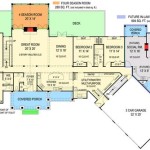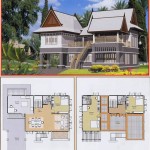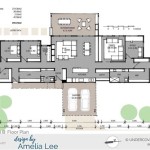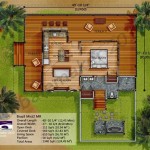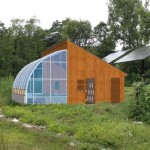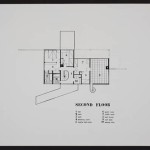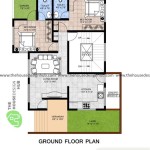Rectangular House Plans with Wrap-Around Porch: A Comprehensive Guide
Rectangular house plans are a popular architectural choice for their simplicity, efficiency, and cost-effectiveness. When combined with a wrap-around porch, these designs offer an extended outdoor living space, enhanced curb appeal, and a seamless connection to the surrounding environment. This article explores the advantages of rectangular house plans with wrap-around porches, key design considerations, and various architectural styles that complement this type of construction.
Rectangular house plans inherently minimize construction costs due to their straightforward design. The simple layout reduces the complexity of the foundation, framing, and roofing, leading to lower material costs and reduced labor hours. The wrap-around porch, while adding an additional element, can still be integrated efficiently into the overall rectangular form, minimizing waste and maximizing the use of space. This combination provides a balance between affordability and desirable features, making it an attractive option for budget-conscious homeowners.
From an aesthetic perspective, the wrap-around porch adds significant character to a rectangular house. The linear geometry of the house plan is softened by the porch, creating visual interest and depth. The porch also provides a welcoming transition from the exterior to the interior, inviting residents and guests to relax and enjoy the outdoors. The added architectural detail elevates the overall appearance of the house, increasing its curb appeal and potentially its market value.
The placement of a rectangular house on a site is often simplified by its shape. This allows for easier orientation to maximize sunlight exposure, views, and natural ventilation. The wrap-around porch further enhances the benefits of site orientation. It can provide shade during the hottest parts of the day, protect the house from wind and rain, and create a comfortable outdoor space for various activities. The porch also acts as a buffer zone, helping to regulate the temperature inside the house and reducing energy consumption.
Advantages of Rectangular House Plans with Wrap-Around Porches
Rectangular house plans with wrap-around porches offer a multitude of advantages for homeowners. These advantages range from functional benefits like increased living space and enhanced outdoor access to aesthetic enhancements that elevate the overall design of the home.
One of the primary advantages is the expansion of living space. The wrap-around porch effectively extends the usable square footage of the house. It provides an outdoor area for dining, relaxing, entertaining, or simply enjoying the surrounding landscape. This is particularly beneficial for those who enjoy spending time outdoors or who frequently host gatherings. The porch can serve as an outdoor living room during the warmer months, providing a comfortable and inviting space for socializing and recreation.
Furthermore, a wrap-around porch enhances the connection with nature. It allows residents to immerse themselves in the surrounding environment, appreciating the beauty of the outdoors. The porch can be furnished with comfortable seating and landscaping to create a tranquil retreat. It also allows for improved ventilation, bringing fresh air into the home and reducing the need for artificial cooling. This enhanced connection with nature can contribute to improved mental and physical well-being.
Another significant advantage is the protection it provides to the house. The porch roof shelters the walls and windows from the elements, reducing wear and tear and extending the lifespan of the building materials. It also provides shade, which helps to keep the interior of the house cooler during the summer months, reducing energy consumption and saving on cooling costs. This protective function is especially important in areas with harsh weather conditions.
Key Design Considerations
Designing a rectangular house plan with a wrap-around porch requires careful consideration of various factors to ensure functionality, aesthetics, and structural integrity. These considerations include porch dimensions, roof design, material selection, and accessibility.
The dimensions of the porch are crucial for its overall functionality and aesthetic appeal. The width of the porch should be adequate to accommodate furniture, walkways, and activities without feeling cramped. A width of at least eight feet is generally recommended for comfortable seating and circulation. The length of the porch should be proportionate to the size of the house, creating a balanced and harmonious appearance. The placement of columns or posts should also be carefully considered to provide structural support and visual appeal.
The roof design of the porch is another important consideration. The roof can be a simple extension of the main house roof, or it can be a separate structure with its own unique design. The pitch of the roof should be sufficient to allow for proper drainage, and the overhang should provide adequate protection from the sun and rain. The roof can be constructed from various materials, such as asphalt shingles, metal roofing, or wood shakes, depending on the desired aesthetic and budget.
Material selection plays a significant role in the durability and appearance of the porch. Decking materials can include wood, composite decking, or concrete. Wood decking offers a natural and warm aesthetic, but it requires regular maintenance to prevent rot and decay. Composite decking is a low-maintenance alternative that mimics the look of wood but is more resistant to the elements. Concrete decking is a durable and cost-effective option that can be stained or stamped to create various textures and patterns. Railing materials can include wood, metal, or vinyl, depending on the desired style and budget.
Accessibility is an important consideration for all house designs, including those with wrap-around porches. Ramps or gradual slopes should be incorporated into the design to provide access for individuals with mobility challenges. Doorways should be wide enough to accommodate wheelchairs or walkers. Railings should be installed at an appropriate height to provide support and safety. These accessibility features ensure that the porch is inclusive and welcoming to all residents and visitors.
Architectural Styles for Rectangular Houses with Wrap-Around Porches
Rectangular house plans with wrap-around porches can be adapted to a variety of architectural styles, each with its unique features and characteristics. Some of the most popular styles include Colonial, Farmhouse, Craftsman, and Contemporary.
Colonial-style houses are characterized by their symmetrical facade, simple lines, and formal appearance. A wrap-around porch can enhance the charm of a Colonial house by adding a welcoming outdoor space. The porch typically features slender columns, decorative railings, and a simple roofline. Common materials include wood siding, painted trim, and brick accents. The porch can be furnished with classic outdoor furniture to create a timeless and elegant look. The addition of shutters and a well-manicured lawn further enhances the Colonial aesthetic.
Farmhouse-style houses evoke a sense of warmth, comfort, and rustic charm. A wrap-around porch is a quintessential feature of a farmhouse, providing a place to relax and enjoy the surrounding countryside. The porch typically features wide planks, exposed beams, and a gabled roof. Common materials include wood siding, metal roofing, and stone accents. The porch can be furnished with rocking chairs, porch swings, and potted plants to create a cozy and inviting atmosphere. The addition of a barn-style door and a picket fence further enhances the farmhouse aesthetic.
Craftsman-style houses are known for their handcrafted details, natural materials, and emphasis on horizontal lines. A wrap-around porch can complement the Craftsman style by providing a sheltered outdoor space that seamlessly blends with the architecture. The porch typically features tapered columns, exposed rafters, and a low-pitched roof. Common materials include wood siding, stone veneer, and copper accents. The porch can be furnished with handcrafted furniture, woven rugs, and artful lighting to create a sophisticated and inviting space. The addition of stained-glass windows and a well-landscaped garden further enhances the Craftsman aesthetic.
Contemporary-style houses are characterized by their clean lines, minimalist design, and emphasis on natural light. A wrap-around porch can add a touch of warmth and personality to a contemporary house while maintaining its modern aesthetic. The porch typically features simple columns, glass railings, and a flat or slightly sloped roof. Common materials include concrete, steel, and glass. The porch can be furnished with sleek outdoor furniture, minimalist lighting, and modern art to create a stylish and inviting space. The addition of a water feature and a well-designed landscape further enhances the contemporary aesthetic.

Lowcountry Style House Plan With Full Wrap Around Porch

Pin On House Plans
:max_bytes(150000):strip_icc()/RX_1909_SL1821-dd6f62380f214b4fb1e6ebd310c4d535.jpg?strip=all)
13 House Plans With Wrap Around Porches

4 Bedroom Single Story Contemporary Country Home With Wraparound Porch Floor Plan Plans House

House Plans With Wraparound Porches Porch Houseplans Com
Southern Living Dreamy House Plans With Front Porches Blog Dreamhomesource Com
House Plan Of The Week Rectangular Ranch With Barndo Style Builder

Southern Style House Plan 3 Beds 2 Baths 1567 Sq Ft 36 136 Homeplans Com
:max_bytes(150000):strip_icc()/HOH_SL1254-d5dcd603b4e042e7852fbb2e93f2e0a5.jpg?strip=all)
13 House Plans With Wrap Around Porches

Wrap Around Porch House Plans

